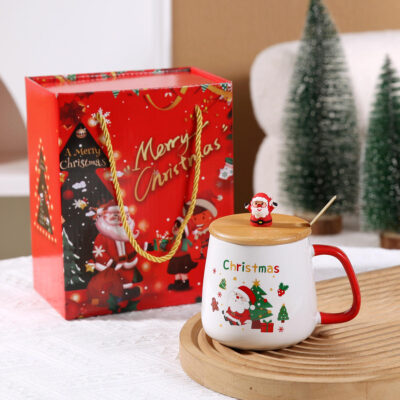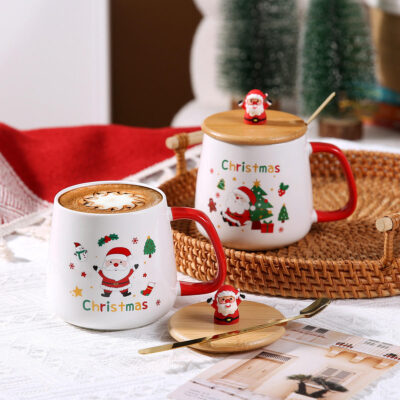Not all ceramic mugs are created equal. The material you choose determines how the mug feels, how long it lasts, and how customers perceive your brand. Whether you’re sourcing from a ceramic mug supplier or designing your own custom line, understanding material differences helps you make smarter, long-term decisions.
☕ 1. Porcelain Mugs – The Elegant Choice
Porcelain mugs are known for their smooth surface, light weight, and refined appearance. They are fired at extremely high temperatures, giving them a delicate texture and pure white base that enhances printed logos and artwork.
Advantages:
-
Smooth and glossy surface ideal for detailed printing.
-
Lightweight yet durable, suitable for restaurants, boutiques, and gifts.
-
Offers a premium look that enhances brand image.
Considerations:
Porcelain is more fragile than other materials, so it requires careful handling and slightly thicker packaging for export. It’s the perfect choice for high-end branding, café chains, or retail lines that want to project sophistication.
If you want to elevate your logo or pattern with precision and color accuracy, custom ceramic mugs made from porcelain deliver the finest aesthetic quality.
🍵 2. Stoneware Mugs – The Everyday Performer
Stoneware is the most common material used in commercial and household mugs. Fired at a lower temperature than porcelain, it has a denser structure and slightly rustic appearance. It’s heavier to hold, which gives users a sense of stability and warmth.
Advantages:
-
Excellent heat retention, ideal for daily coffee and tea.
-
Naturally strong and resistant to chipping.
-
Compatible with most glazing and printing techniques.
Considerations:
Stoneware tends to be less white, so printed colors may appear warmer or softer. However, this works perfectly for lifestyle or handmade-style collections.
A ceramic mug factory can customize stoneware mugs with different shapes, glazes, or matte finishes, making them versatile for cafés, souvenir shops, or promotional projects that emphasize durability over delicacy.
☕ 3. Enamel-Coated Ceramic Mugs – The Retro Style
Enamel-coated ceramics combine the charm of traditional enamelware with the durability of ceramics. These mugs often feature vintage designs, making them popular among outdoor, camping, and lifestyle brands.
Advantages:
-
Tough and resistant to scratches or temperature change.
-
Retro aesthetic suitable for outdoor and promotional markets.
-
Wide design flexibility with colored rims or patterns.
Considerations:
Enamel coatings require careful firing and surface preparation to avoid uneven texture. This type of mug is heavier and has a distinctive tactile feel that appeals to niche audiences looking for nostalgic or rugged design elements.
A professional ceramic mug manufacturer can ensure that enamel-coated ceramics maintain both aesthetic appeal and long-term durability through precise firing control.
🔍 4. Comparing the Three Materials
| Feature | Porcelain | Stoneware | Enamel-Coated Ceramic |
|---|---|---|---|
| Appearance | Smooth, pure white | Matte or glossy, earthy tones | Glossy, vintage aesthetic |
| Durability | Light but delicate | Strong and chip-resistant | Tough and scratch-proof |
| Weight | Light | Medium to heavy | Medium |
| Heat Retention | Moderate | Excellent | Very good |
| Printing Options | Best for detailed logos | Suitable for most prints | Limited to surface patterns |
| Best For | Premium retail, cafes | Daily use, wholesale, gifts | Outdoor, promotional lines |
This comparison makes it clear: porcelain suits premium branding, stoneware fits practical mass use, and enamel-coated ceramics stand out for creative or outdoor markets.
🌍 5. Sustainability and Safety Factors
In today’s market, buyers also care about sustainability and safety. When choosing a ceramic mug supplier, confirm that they use lead-free glazes, non-toxic inks, and eco-friendly firing systems. Many modern factories have upgraded to energy-efficient kilns and water-recycling production lines.
These certifications — such as LFGB, FDA, or REACH — ensure that your mugs are safe for everyday use and compliant with global import standards. Sustainable production not only benefits the planet but also enhances your brand’s reputation among eco-conscious consumers.
🧠 6. Final Decision: Balancing Style, Function, and Brand
Ultimately, the best choice depends on your brand’s positioning and audience.
-
Choose porcelain if elegance and precision matter most.
-
Choose stoneware for strength and everyday function.
-
Choose enamel-coated ceramics if your brand values creativity, nostalgia, or outdoor durability.
A professional ceramic mug manufacturer can even combine elements — for example, applying enamel-style finishes to stoneware or custom glazes to porcelain — giving you both flexibility and exclusivity.
✨ Conclusion
Selecting the right material for your ceramic mugs is a key step toward defining your brand’s quality and feel. Each option offers unique advantages that suit different audiences and purposes.
By partnering with an experienced ceramic mug factory, you can explore material samples, test glazes, and develop mugs that perfectly balance durability, design, and identity. When your customer picks up the mug, they should not only feel its weight — they should feel your brand’s value in every detail.








